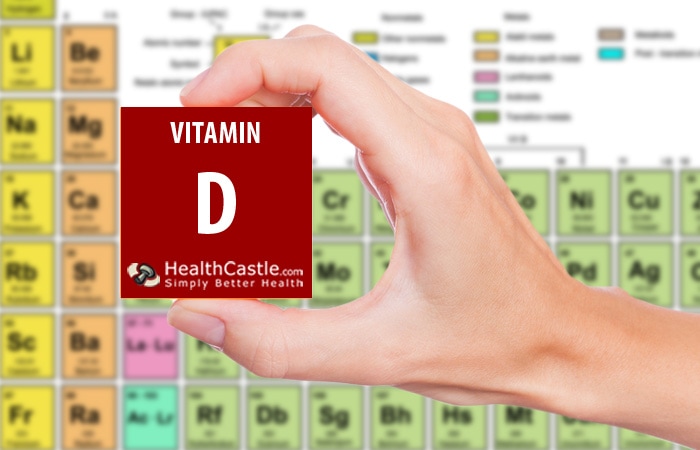
Written By: Sofia Layarda, MPH
Title: Master of Public Health
Alumni: University of California, Berkeley
Last Updated on:


Vitamin D is one of the most talked about and researched nutrients. Often mentioned in the same breath as calcium, fat-soluble Vitamin D’s important role in optimal bone health is well documented. While exposure to sunlight does trigger Vitamin D production, recommended intakes are based on minimal sun exposure.
Table of Contents
The Dietary Reference Intakes (DRI) for Vitamin D are shown below:
| Age Group | Recommended Dietary Allowance (RDA) per Day | Tolerable Upper Intake Level (UL) per Day |
| Adults | ||
| 19 to 50 years | 600 IU (15 mcg) | 4,000 IU (100 mcg) |
| 51 to 70 years | 600 IU (15 mcg) | 4,000 IU (100 mcg) |
| 71 years and up | 800 IU (20 mcg) | 4,000 IU (100 mcg) |
| Kids and Youth | ||
| 1 to 13 years | 600 IU (15 mcg) | 2,500 IU (63 mcg) |
| 14 to 18 years | 600 IU (15 mcg) | 3,000 IU (75 mcg) |
| Special Considerations | ||
| Pregnancy and Lactation | 600 IU (15 mcg) | 4,000 IU (100 mcg) |
Note: For very young children, the reference level provided is adequate intake (AI) of 400 IU (10 mcg). The American Academy of Pediatrics recommends that partially or exclusively breastfed infants be supplemented with 400 IU of Vitamin D per day.
Vitamin D’s main role is in the maintenance of healthy bones and teeth. Vitamin D is needed for bone growth and remodeling and promotes the absorption of calcium in the digestive tract. It is involved in regulating the levels of calcium and phosphate in the blood, which ensures proper mineralization of bone. Vitamin D deficiency can lead to low serum calcium levels, resulting in calcium being pulled out of bones. Vitamin D deficiency can cause rickets in children, while in older adults it can cause softening or severe weakening of the bones (osteoporosis).
In addition to its well-known role in bone health, Vitamin D is involved in modulating cell growth and neuromuscular function, and appears to play a role in both immunity and reducing inflammation. Emerging research suggests that Vitamin D may play a role in the prevention and/or treatment of some medical conditions; however, the evidence is currently not deemed rigorous enough to warrant prescription of specific Vitamin D levels for prevention of these conditions.
If you wear sunscreen all year round, your skin is not able to produce Vitamin D from direct sunlight, so you may want to consider taking Vitamin D supplements. Indeed, in Canada, routine daily Vitamin D supplementation of 1,000 IU is recommended for all adults during the winter months as a cancer-preventative measure. However, too much Vitamin D is not necessarily a good thing. Vitamin D toxicity can result in over-calcification (too much calcium deposited) in soft tissues and blood vessels, leading to organ damage (heart, kidney, lungs). Vitamin D from the foods we eat is highly unlikely, so the likely chance for overdosing comes from supplements.
| Food | Vitamin D per serving |
| Salmon, sockeye, baked, 3 oz | 447 IU |
| Tuna, canned, drained, 1 can | 148 IU |
| Sardine, Pacific, canned in tomato sauce, 2 pieces | 147 IU |
| Milk, cow’s, fortified with Vitamin D, 1 cup | 110 to 124 IU (the higher the % fat, the higher the Vitamin D) |
| Yogurt, low-fat, vanilla flavor, fortified with Vitamin D, 1 cup | 115 IU |
| Milk alternative, soy or almond, fortified with Vitamin D, 1 cup | Varies depending on brand; 40 IU to 120 IU |
| Orange juice, fortified with Vitamin D, 1 cup | 100 IU |
| Margarine, fortified with Vitamin D, 1 tbs | 60 IU |
| Egg, 1 large | 41 IU |
| Breakfast cereal, Kellogg’s Corn Flakes, 1 cup | 40 IU |
| Breakfast cereal, General Mills Cheerios, 1 cup | 38 IU |
| Mushrooms, white, raw, 1 cup slices | If treated with UV rays (such as from the sun), can provide as much as 400 IU per serving.Otherwise, 5 to 7 IU |
| Cheese, cheddar, 1 oz slice | 7 IU |
In the United States: The Daily Value for Vitamin D is set by the Food and Drug Administration (FDA) at 400 IU for ages 4 and older, which is less than the RDA of 600 IU.
Food labels are not required to show Vitamin D content unless the food has been fortified with this vitamin. The number you see on the Nutrition Facts label is a percentage calculated by dividing the amount of Vitamin D in one serving of the food by the daily value. For example, a tablespoon of Vitamin D-fortified margarine that contains 60 IU has 15% of the daily value (DV) for Vitamin D but actually provides only 10% of the recommended intake of 600 IU.
In Canada: The Daily Value for Vitamin D is 200 IU, which is much lower than the RDA of 600 IU. This can be very misleading for the consumer. For example, the same tablespoon of Vitamin D-fortified margarine that contains 60 IU would be shown as having 30% of the daily value (DV) for Vitamin D but still actually provides only 10% of the recommended intake of 600 IU.
Calcium: Vitamin D is needed for optimal calcium absorption in the digestive tract, and is also involved in the regulation of serum calcium levels.
Alumni: University of California, Berkeley – Sofia believes in bringing back fun and pleasure into everyday eating. She loves cooking, and is constantly experimenting with ingredients, creating recipes and trying them out on family and friends. Her latest interest lies in finding realistic and practical ways of environmentally-friendly food/eating habits.
immune booster, micronutrient - vitamins, osteoporosis, vegetarian, vitamin d, vitamins, vitamins - minerals